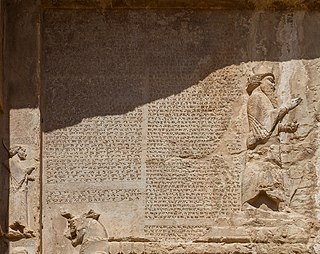
The Behistun Inscription is a multilingual Achaemenid royal inscription and large rock relief on a cliff at Mount Behistun in the Kermanshah Province of Iran, near the city of Kermanshah in western Iran, established by Darius the Great. It was important to the decipherment of cuneiform, as it is the longest known trilingual cuneiform inscription, written in Old Persian, Elamite, and Babylonian.

In mathematics, an ellipse is a plane curve surrounding two focal points, such that for all points on the curve, the sum of the two distances to the focal points is a constant. It generalizes a circle, which is the special type of ellipse in which the two focal points are the same. The elongation of an ellipse is measured by its eccentricity , a number ranging from to .

In physics, the kinetic energy of an object is the form of energy that it possesses due to its motion.

Ionia was an ancient region on the western coast of Anatolia, to the south of present-day İzmir, Turkey. It consisted of the northernmost territories of the Ionian League of Greek settlements. Never a unified state, it was named after the Ionians who had settled in the region before the Archaic period.

The Schrödinger equation is a linear partial differential equation that governs the wave function of a quantum-mechanical system. Its discovery was a significant landmark in the development of quantum mechanics. It is named after Erwin Schrödinger, who postulated the equation in 1925 and published it in 1926, forming the basis for the work that resulted in his Nobel Prize in Physics in 1933.

The Ionians were one of the four major tribes that the Greeks considered themselves to be divided into during the ancient period; the other three being the Dorians, Aeolians, and Achaeans. The Ionian dialect was one of the three major linguistic divisions of the Hellenic world, together with the Dorian and Aeolian dialects.
Gregory Bar Hebraeus, known by his Syriac ancestral surname as Barebraya or Barebroyo, in Arabic sources by his kunya Abu'l-Faraj, and his Latinized name Abulpharagius in the Latin West, was a Maphrian of the Syriac Orthodox Church from 1264 to 1286. He was a prominent writer, who created various works in the fields of Christian theology, philosophy, history, linguistics, and poetry. For his contributions to the development of Syriac literature, has been praised as one of the most learned and versatile writers among Syriac Orthodox Christians.

The word Yona in Pali and the Prakrits, and the analogue Yavana in Sanskrit and Yavanar in Tamil, were words used in Ancient India to designate Greek speakers. "Yona" and "Yavana" are transliterations of the Greek word for "Ionians", who were probably the first Greeks to be known in India.
In linear algebra, it is often important to know which vectors have their directions unchanged by a given linear transformation. An eigenvector or characteristic vector is such a vector. Thus an eigenvector of a linear transformation is scaled by a constant factor when the linear transformation is applied to it: . The corresponding eigenvalue, characteristic value, or characteristic root is the multiplying factor .
Yauna refers to variously

Tucanoan is a language family of Colombia, Brazil, Ecuador, and Peru.

Ionia, known in Old Persian as Yauna, was a region within the satrapy of Lydia, with its capital at Sardis, within the First Persian Empire. The first mention of the Yauna is at the Behistun inscription.

The Macuna are a Tucanoan-speaking group of the eastern part of the Amazon basin, located around the confluence of the Pira Paraná River and Apaporis river, in the Colombian Vaupés Department and the Brazilian state of Amazonas. There are no reliable census data for the Macuna. The entire population was estimated at some 600 individuals in 1991, of which 450 lived in Colombia.
The name of Greece differs in Greek compared with the names used for the country in other languages and cultures, just like the names of the Greeks. The ancient and modern name of the country is Hellas or Hellada (Greek: Ελλάς, Ελλάδα; in polytonic: Ἑλλάς, Ἑλλάδα), and its official name is the Hellenic Republic, Helliniki Dimokratia. In English, however, the country is usually called Greece, which comes from the Latin Graecia.

Skudra was a province (satrapy) of the Persian Achaemenid Empire in Europe between 510s BC and 479 BC. Its name is attested in Persian and Egyptian inscriptions (an Egyptian record of c. 498–497 BC, and a list on the tomb of Darius the Great at Naqsh-e Rustam, c. 486 BC. It is believed to have comprised the lands now known as Thrace and Macedon.

The members of the Delian League/Athenian Empire can be categorized into two groups: the allied states (symmachoi) reported in the stone tablets of the Athenian tribute lists, who contributed the symmachikos phoros in money, and further allies, reported either in epigraphy or historiography, whose contribution consisted of ships, wood, grain, and military assistance; proper and occasional members, subject members and genuine allies.
Hote (Ho’tei), also known as Malê, is an Oceanic language in Morobe Province, Papua New Guinea.

The DNa inscription is a famous Achaemenid royal inscription located in Naqsh-e Rostam, Iran. It dates to c. 490 BCE, the time of Darius the Great, and appears in the top-left corner of the façade of his tomb.

Unggai Rural LLG is a local-level government (LLG) of Eastern Highlands Province, Papua New Guinea.













